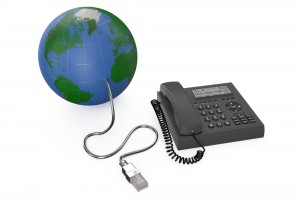3 Things to Consider When Choosing a VoIP System
 More businesses are adopting Voice over Internet Protocol (VoIP) solutions than ever before. From streamlined platforms to centralized communications, VoIP is a truly cost-effective and flexible alternative to outdated phone systems. VoIP improves operational efficiency, cuts telecommunication costs, and increases overall performance. The preferred choice for countless brands and ventures, VoIP easily integrates into any existing telephony system or communications protocol.
More businesses are adopting Voice over Internet Protocol (VoIP) solutions than ever before. From streamlined platforms to centralized communications, VoIP is a truly cost-effective and flexible alternative to outdated phone systems. VoIP improves operational efficiency, cuts telecommunication costs, and increases overall performance. The preferred choice for countless brands and ventures, VoIP easily integrates into any existing telephony system or communications protocol.
Within the VoIP market, however, there are several brands and services available. The only way to secure the best VoIP package is to conduct extensive research. When it comes to the right system for your business, there are three important aspects to consider.
Scalability
Scalability should be of paramount concern when selecting a VoIP system. Companies should look for the following before choosing a service provider:
- affordable VoIP services that promote brand growth and expansion;
- seamless integration of VoIP into existing telephony and business communications platforms;
- file sharing, screen sharing, uploads, downloads, and any other specific features that are needed by the business;
- Session Initiation Protocol (SIP) trunking to expand or reduce business lines on an as-needed basis; and
- compatibility between private branch exchange (PBX) and SIP, with the flexibility to enhance, edit, or bring on new services.
Hosted vs. On-site Services
There are hosted and on-site options available for PBX services. Both have their unique advantages and disadvantages and should be taken into consideration when adopting new VoIP platforms.
Hosted PBX
- Businesses without existing PBX hardware tend to benefit from cloud-hosting services.
- Cloud services are easier to deploy, are more cost-efficient, and eliminate the need to purchase new hardware and pay maintenance fees.
On-site PBX
- On-site systems offer more flexibility and better control over private telecommunications networks.
- On-site PBX is the best option for companies that have the means to invest in hardware and maintenance for optimal system functionality.
Deciding between on-site and remote services depends on the particular needs of the company. Businesses should also weigh the benefits and risks of deploying these services before signing their names on the dotted line.
Workforce Mobility
With the advent of burgeoning technologies and bring your own device (BYOD) policies, more and more employees are able to get work done while on the go. In fact, many now use their own mobile, wireless, and digital devices from remote venues. With this in mind, businesses need to integrate contact lists, video conferencing, and call-forwarding services for their remote teams.
With modern VoIP features, businesses are also able to secure more freedom and flexibility for workers. They no longer have to invest in expensive tools for mobile workforces, since the same applications and programs are being utilized across the board.
SIP Trunking or Hosted PBX: Telephony Planning for a Growing Business
 Every growing enterprise faces choices about the best telephony solution to meet its needs. Session Initiation Protocol (SIP) trunking or a hosted private branch exchange (PBX) are both viable solutions, but a business must determine which is more suited to its particular requirements.
Every growing enterprise faces choices about the best telephony solution to meet its needs. Session Initiation Protocol (SIP) trunking or a hosted private branch exchange (PBX) are both viable solutions, but a business must determine which is more suited to its particular requirements.
Exploring the Similarities and Differences Between SIP Trunking and Hosted PBX
At first glance, SIP trunking and hosted PBX seem very similar. Both are IP-based systems and offer the same basic services such as:
• streaming audio and video;
• VoIP telephone connections to include local, long distance, and toll-free lines;
• support of both mobile and fixed phone systems; and
• support of data transmission for email, fax, text messages, and Internet access.
However, one of the primary differences between the two is that a SIP trunking system requires fixed assets and support, whereas hosted PBX does not.
Hosted PBX is generally a service provided by a vendor that requires neither an investment in equipment nor staff to oversee the system. This is a lower cost solution, but it is completely dependent on a third party for the operation of a vital business asset.
A SIP trunking solution requires an initial investment in expensive equipment and infrastructure as well as the ongoing cost of maintenance and service professionals. But despite these costs, this investment can lead to long-term flexibility and room for growth.
Size Matters
Smaller businesses will often benefit more from hosted PBX. Essentially an all-in-one telecommunications provider, the hosted PBX vendor delivers a hands-free telephone system that meets a small business’s needs without the cost of equipment and dedicated staff. Additionally, because hosted PBX is cloud-based, a small business has the option to switch providers without any significant interruption of service.
But as a business grows, it often needs much greater use of bandwidth and therefore requires more resources. A hosted PBX service can be expanded to compensate for the greater needs of a larger business, but this is usually accomplished at a higher cost. Eventually, there comes a point in a business’s growth when it becomes more efficient to opt for a SIP trunking solution.
A larger business with a SIP Trunking solution is able to manage its critical telecommunications system in-house and does not have to rely on an external supplier. This affords the business a level of self-reliance and allows for more overall bandwidth as well as room for growth.
Looking Ahead
Ultimately, it seems that both SIP trunking and hosted PBX systems have a future in enterprise telephony. Both systems are well suited to a particular clientele and have enough overlap in customer base to allow for healthy competition. Choosing between SIP trunking or hosted PBX is a matter of analyzing a business’s current and long-term needs.
The Ever-Evolving VoIP
 The birth cry of the Internet came about in the U.S. when the Advanced Research Projects Agency Network (ARPANET) delivered the first data packet between two computers in 1969. That very same ARPANET saw the birth of Voice over Internet Protocol (VoIP) when the first data packet of encoded voice was transmitted in 1974. In recent years, the dawning and proliferation of the information age has seen VoIP truly come into its own.
The birth cry of the Internet came about in the U.S. when the Advanced Research Projects Agency Network (ARPANET) delivered the first data packet between two computers in 1969. That very same ARPANET saw the birth of Voice over Internet Protocol (VoIP) when the first data packet of encoded voice was transmitted in 1974. In recent years, the dawning and proliferation of the information age has seen VoIP truly come into its own.
An Innovation in the Data World
From businesses to the home internet connection, relatively inexpensive high speed internet is allowing VoIP to replace traditional telephone services. In all but the most remote rural areas, sufficient internet speeds are now available, prompting consumers to question the need for both telephone and internet services when internet will serve both voice and data functions.
Affordability and Convenience
In the past there has been resistance to innovations such as VoIP due to cost and the dread of having to get a new telephone number. That is no longer the case. VoIP equipment is highly affordable and often is less costly than even an average smartphone. Further, the cost of transmitting a data packet over long distance is hardly more than the cost to send the same data packet across the room, making VoIP more affordable than traditional long distance telephone services.
In the early days, a VoIP call had to go through a third party because telecommunications companies held a certain level of propriety over the connections. Now, VoIP calls go directly to the recipient, bypassing the middleman and keeping costs low.
Changes in FCC laws now allow phone numbers to be transferred from one service to another. The process of making the change takes just moments, and the service provider is usually happy to do the work in order to get new business. The service itself is has yearly costs comparable to regular monthly cellular phone charges.
Services That Are Part of the Package
Most VoIP packages include long distance as just another service provided for a very low single fee if not provided entirely for free. A number of services once considered to be extras were billed as such but are now being provided by VoIP as a standard package. Some of these standard services provided at little to no additional cost include call forwarding, voicemail, and call waiting.
Marrying VoIP to Apps
VoIP is IP-based and highly adaptable with regard to data handling applications. As a result, VoIP telephony systems are capable of previously unheard of functions and new applications are arriving on the scene every day. From screen sharing to faxing to email, the IP-based world is growing and expanding in capabilities at a mind-boggling rate. With the affordability of VoIP services being realized, what was once thought to be a tool for businesses has taken root in the home.
